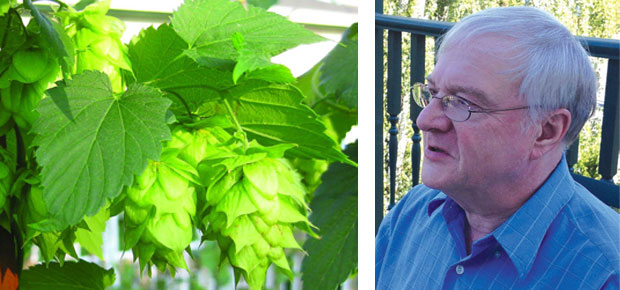Professor Karl Siebert answers that question, and many others, in his courses on making and tasting beer
Professor Karl Siebert answers that question, and many others, in his courses on making and tasting beer
As a young man coming of age in Harrisburg, Pennsylvania, Karl Siebert wasn’t much for beer. During the seven years he spent at Penn State in the Sixties earning a bachelor’s degree and a PhD in biochemistry, his social lubricant of choice was a mixed drink—even when a Stroh’s interview committee invited him to lunch during the interview process for a post in the Detroit brewery’s research department. Everyone else at the table ordered the local suds, but Siebert followed the lead of the head scientist and ordered a cocktail. “In retrospect, that was really stupid,” says Siebert, now a Cornell professor of food science, “but it worked out.”
Indeed. The folks at Stroh’s cared more about Siebert’s scientific acumen than his bar preferences, and he spent nearly two decades at the brewery, ascending to director of research. In 1990, Siebert became head of Cornell’s Department of Food
Science and Technology at the New York State Agricultural Experiment Station in Geneva. Today he’s the University’s self-described “beer prof,” a member of the four-professor team that teaches Understanding Wine and Beer, Cornell’s only for-credit course devoted to the science of fermentation and brewing.

In February, Siebert launched the Brewing Science and Technology Short Course, a nine-hour extension program for professional and home brewers. More than seventy students—including pros from Otter Creek, Empire Brewing Company, Ommegang, and Long Trail—signed up before enrollment maxed out the Geneva campus’s largest auditorium. (Another session is scheduled for October.) “The interest in making beer on the part of both home brewers and small brewers—brew-pubs and craft brewers—has mushroomed incredibly in recent years,” says Siebert, who covered such topics as the vocabulary of the brewing process, the agronomy of barley and hops, and the biochemistry of fermentation. “At the lowest point—in the Seventies—there were as few as fifteen brewing companies in this country; now there are hundreds. Every time you turn around, someone’s starting up a new one.”
In addition to Siebert’s lectures—and a lunch enlivened by samples from participating brewers—the short course featured Cooperative Extension hops specialist Steve Miller, who gave a talk on the blossoms central to beer’s creation. Hoping to connect with brewers, enrich his understanding of the overall brewing process, and gauge interest in local sourcing, he wound up sticking around for the full day. “There are about a hundred microbrewers in New York State now, plus the ones in New England,” says Miller, noting that he expects there will be more than a hundred acres of hops vines planted statewide in time for the 2013 harvest. “This is why we’re able to start a hop industry here—because there’s a whole new group of people to sell to. Brewers are anxious to get New York State-grown hops, to say in their marketing that they’re buying from local growers or growing their own.”
With a farm brewery bill signed by Governor Andrew Cuomo in mid-July, that trend is likely to accelerate. Modeled on the Farm Winery Act of 1976 (co-authored by John Dyson ’65), which allowed grape growers to ferment and bottle their harvest for direct sale, the bill lets microbrewers sell their products on their premises, providing they’ve sourced the majority of the ingredients from New York growers. “Whether legislators realize it or not,” says Siebert, “it will have a huge influence on agricultural production of certain crops.”
Siebert’s expertise spans food chemistry and microbiology as well as sensory analysis; he has tackled such research topics as the role of various proteins in beer that promote foaming, create haziness, and influence mouth-feel and flavor. He started co-teaching Understanding Wine and Beer in 2000, joining forces with fellow food science faculty to offer a science-based alternative to the Hotel school’s Introduction to Wines. Unlike Siebert’s comparatively layman-friendly day-long extension program, the three-credit course delves deeply into the physiology of olfaction and taste, the influence of water chemistry on beer styles, and the microbiology of the yeast central to brewing and fermentation.
Like Intro to Wines and the short course, Understanding Wine and Beer features tastings; students must be twenty-one or obtain a waiver from their adviser testifying to its academic pertinence. In its early years, the course had an impressively high attrition rate, a trend Siebert attributes in part to those tastings. “Not only do they taste nice things, there are nasty things as well,” says the professor, who illustrates the protective effect of green glass with a particularly noxious offering of Heineken that has been exposed to fluorescent light. “We also talk about chemistry and microbiology—and, horrors, we expect them to learn it and we test them on it.” In recent years, enrollment has held steady at about 100 students. “I guess,” Siebert says, “the word got out about the science.”


